Electric shocker or stun gun or electrocuter or "portable anti-riot device" is
easy to obtain in our days. Once upon a time such devices were designed
as that:

(The scheme is without any details - only to illustrate the operation
principles)
I.e. stun gun resembled a portable tesla-coil, where the primary capacitor
was charged by a small flyback power unit and then discharged through a
small air spark gap (about 1 mm wide). For a DIY'er this device was of low
interest, except maybe the direct use... however it is doubtfull that
RF curent in form of decaying oscillations could make any harm to a bully.
The time have changed and the modern stun gun (at least all models that
I've seen) is so called "direct current device". I.e. it is just a pocket
high voltage power unit. Its output power and voltage may vary greatly
from model to model. And there are a lot of'em on the market.
 
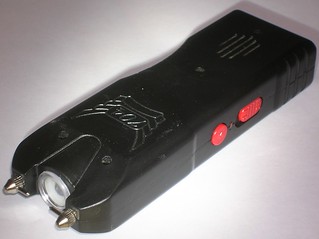
One should never believe the technical data provided by the manufactorer
dor distributor in the form of text on the box or in the applied sheet of
paper. Sometimes the lie is obvious like the sign "8800 Kvolts" (judge
by Yourself hou big would be a device which really gives eight megavolts).
Sometimes the desinformation is not so obvious.
Mostly one can use a simple rule: the greater stun gun looks the higher
voltage it gives. However there are some exclusions. E.g. stun guns of
JSJ-704, WS-704 ane (simply) 704 models have the same outfit. But their max
output is: JSJ-704 - 26 kV; WS-704 - 22 kV; 704 - 18 kV. (It even seems
that WS-704 is a false JSJ-704 and the 704 is a false WS-704.)
One could also use a spark gap value (th distance between HV pins), however
most stun guns have this distanse set to 10..15 mm and they avoid to make it
more.
The range of output voltage is generally about 10..30 kV. I havent yet seen
a stun gun that refused to give 10 kv. And from the other side none of them was
able to reach 30 kV even with a forsage (by applying higher feeding voltage).
The output power at the matched load (i.e. when load resistor causes drop
of the output voltage to its half) is 2..3W for smaller devices and 10..15 W
for the large ones.
THE PROPERTIES OF A TYPICAL STUN GUN
- When the device is turned on the output capacitor (or to be more precise,
the capacity of the output voltage multiplier) begins to charge and the voltage
rises untill the breakdown between the HV pins. I.e. the output voltage is
limited by the breakdown n between the HV pins.
- When the distance between the HV pins is increased (when You cut the pins
or turn them to an angle, or just change them to another type) the output
voltage of the stun gun rises up to a certain limit, which depends to the
model of the stun gun. And after that certain limit the stun gun dies and cannot
be repaired (at least at low cost).
Some too low voltage devices are unable to suicide at the free run. This fact
can be fixed by rising their feeding voltage. One can increase the output for
such models by 10..20% then they die too.
In this file the maximal output voltage of the stun gun means the top
achievable voltage at which the stun gun still alive. Exacly die to the risk of
fatal failure the manufacturers do not like to increase the distance between
the HV pins. They prefer to stay on the safer side with a great surplus.
- The stun guns can be connected in series. In this case the maximal output
voltage is the sum of the ones for the used types of stun guns.

For several reasons I doubt that one can reliably obtain voltages higher than
40..50kV by this way.
- They say that when stun gun is plugged to the mains (to charge the
accumulator) it is strictly forbidden to turn the stun gun on (in the stun gun
mode). It is said to become dead at once. I didnt want to expend a stun gun to
just check up this expression so its up to You to trust it or not.
THE STUN GUN INSIDE.
Here is a photo of a stun gun having been opened.
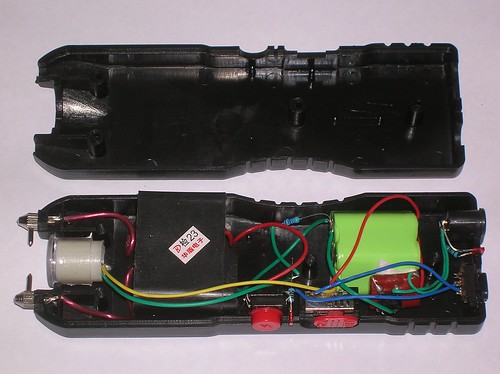
The "heart" of the stun gun is its high voltage module - the epoxy unit
having a parallelepiped shape. (A flashlight type stun guns have elongated
shape more close to a cylinder). Due to the fact that the epoxy fillment
cannot be disassembled in nondestructive way, the burnt stun gun cannot be
repaired.
Making the epoxy soft by means a two week bathing in acetone and then by
gentle removimg the epoxy one can obtain a sense how the HV module designed
inside. It contains a semiconductor element (a transistor or a three-legged
microchip like TOP-220), a sectioned HV transformer (looking like a small
flyback one), and the output rectifier designded as voltage doubler (two
diodes and two capacitors). Therefore the overall circuit looks kinda like
this:

The excessive details are omitted (like indicator LEDS, multiple of switches
and so on). The bridge rectifier at the left of the picture is used to charge
the accumulator batterry from the mains. The epoxy-filled HV module is shown by
the rectangle. The scheme of its AC generator is still unclear, but the
indirect marks imply that there is a banal blocking-generator.
STUN GUN APPLICATIONS
The use of handheld High Voltage Power Supply is quite extensive.
- Here is a photo and video of a small helium-neon laser, powered directly from the stun gun:
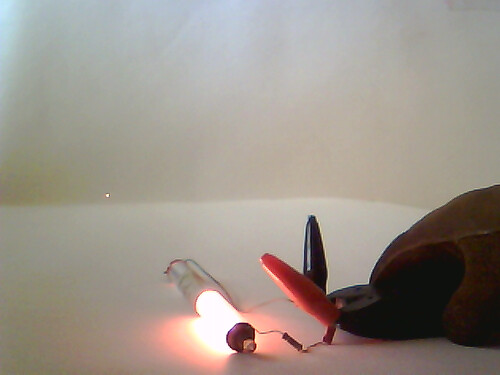
- Here is a small air nitrogen laser, also powered directly from the stun gun.
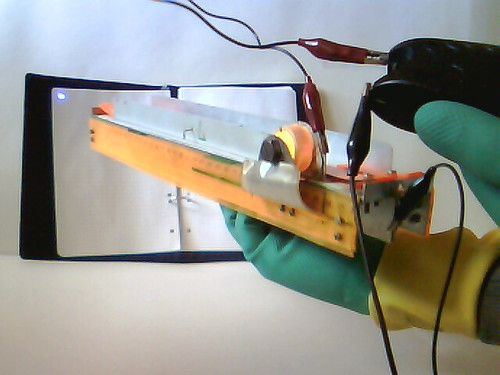
- For bigger lasers (such as TEA CO2 lasers atmospheric pressure) is better to use two series stun gun.
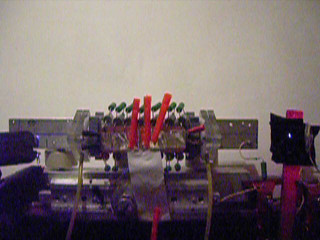
- With stun gun can be tested abrasive bars for the content of silicon carbide and suitability for laser electrodes.
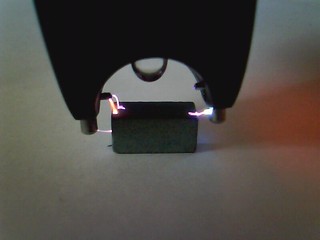 
To the left is shown as a stun gun behaves with carborundum and right - how it behaves when non-conductive bar.
- You can feed the gas-discharge lamps - from usual fluorescent lamps to small xenon lamps:
 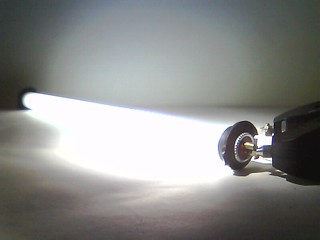
By the form of the discharge in the lamp, you can identify where stun gun "plus" and where "minus"
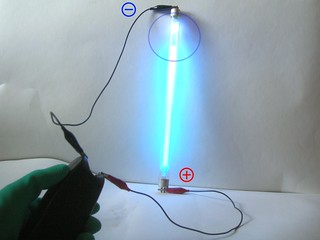
And just a lot of diverse fan:
- discharge on the surface of the water
- discharge on the surface of BaTiO3
- discharge over a sheet of metal coated plastic film
|
|
<< HOME PAGE |



